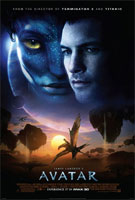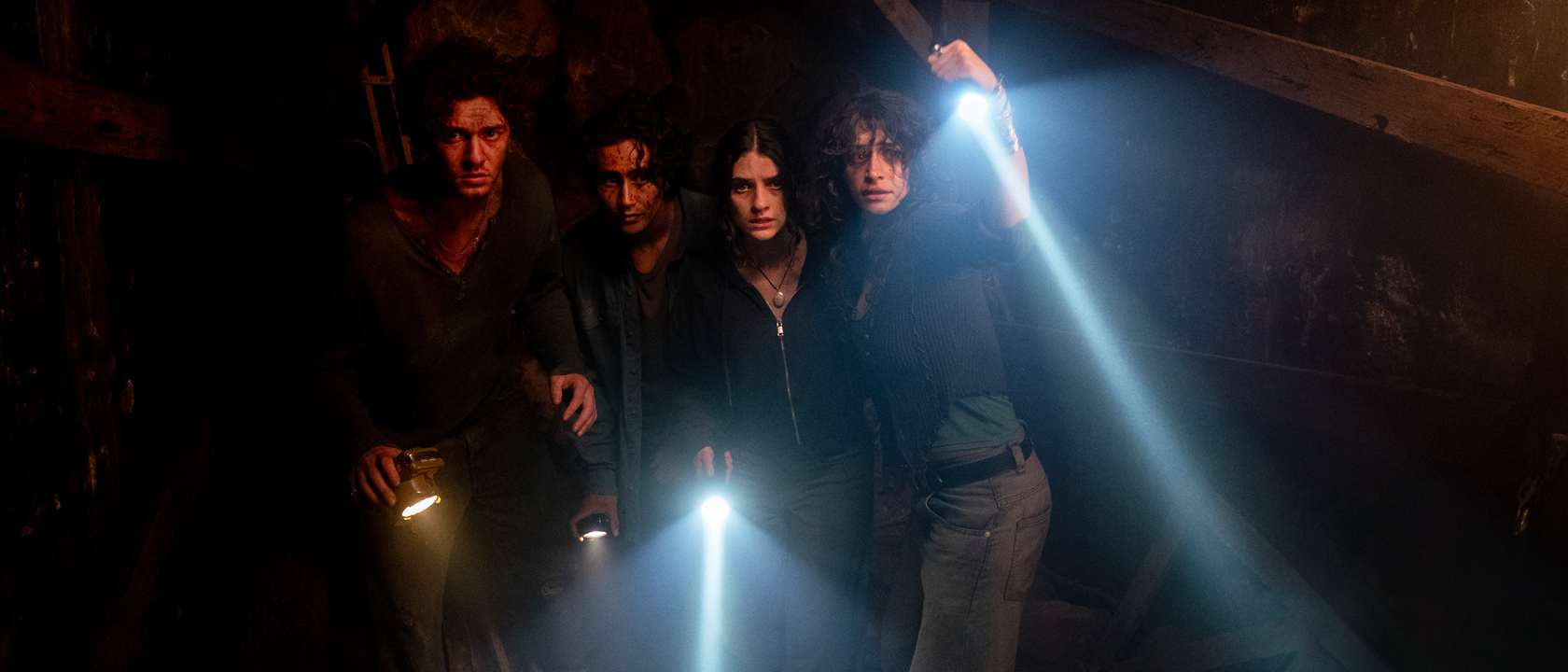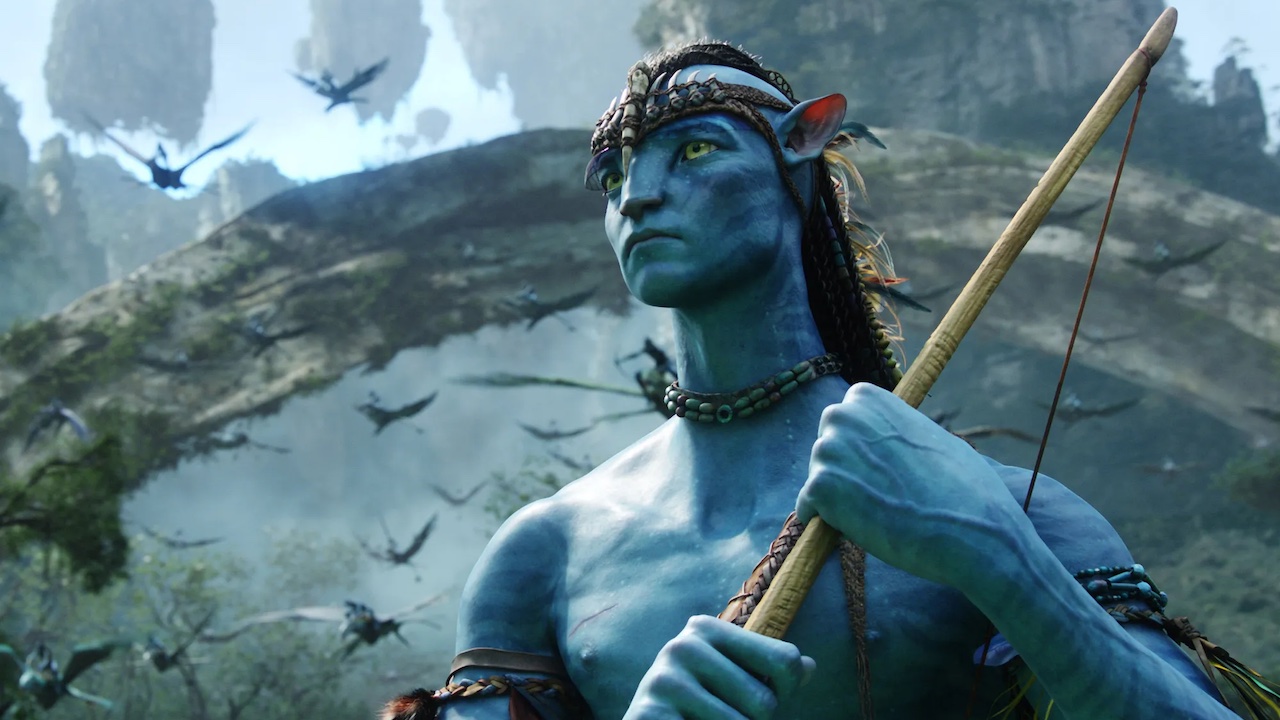There’s been a lot of talk, leading up to its release, about whether or not Avatar is really as original as its makers claim. The naysayers were right. Avatar is Pocahontas and Dances with Wolves and Quigley Down Under and whatever other movie comparisons you want to throw at it. It’s all true. This is a story that’s been told a million times before. Wearing the hats of both writer and director, James Cameron has taken that well-traveled story and slapped a bunch of blue aliens on it. There’s nothing original here and thank god for it. That utter lack of originality is the only thing that saves this bloated, mega-movie.
Our adventure beings with Jack Sully (Sam Worthington) an ex-marine and current paraplegic living in a far off future and hired by a mega-corporation as a stand in for his recently deceased twin brother. As luck would have it, Jake’s twin had been in training to be part of the AVTR program, in which his DNA was cloned to create an alien body which he could control remotely on a far off alien world. Jake replaces his brother with dreams of using his legs again bouncing around in his head. On Pandora he finds a blue-skinned population of natives, which he infiltrates, and falls in love with.
The natives, called Na’vi, aren’t particularly friendly but, they are eerily sexy. They also don’t wear clothes though, lucky for Avatar’s PG-13 rating, the female members of the tribe wear bead necklaces which conveniently drape across most of the bosom. If a nipple should pop through, don’t worry censors, it’s blue and animated. There’s a great drinking game in here somewhere and as soon as Avatar hits DVD I plan to organize a round of spot the nipple do a shot. For now, who has the time when the Na’vi are being threatened by evil humans who want to kill them and exploit their land? Will Jake put it all on the line to save his primitive girlfriend or will she be just another interspecies one night stand?
Here’s the problem: Avatar doesn’t make any sense. This is a movie so poorly written that it must resort to narration and worse (shudder), video blogging, as a way to hold its shambling, rickety narrative together. Even a cursory examination of the story’s specifics reveals gaping plot holes and confusing character motivations. Much of it doesn’t work, or it wouldn’t work, except that we’ve been conditioned to accept it. We accept it because we’ve seen this movie before. We know this formula, we know how it’s supposed to go.
So when the movie’s human supporting cast decides, for all intents, to commit suicide by helping Jake fight for the alien Na’Vi, we don’t question it. Sure it makes no sense for them to aid these unfriendly blue natives whom they barely know in fighting off their human brethren since, if they win, they’ll be cut off from supply and safety dooming themselves either to suffocation as their air runs out or to a slow death in the jungle where they’ll be eaten by hostile plant life. No reasonable person would ever do that, but we accept it because that’s what always happens in these movies. The good guys always help the natives defeat the evil military or the rich white man or the bloated corporate minions. That’s what heroes in this formula do, even if it doesn’t make any sense.
Or take the movie’s obligatory villain; a corporate run military unit which is, theoretically, full of competent ex-marines and led by a legendary badass named Colonel Quaritch. Except Quaritch is a man so cartoonishly evil that he too chooses suicide rather than kill fewer, helpless innocents. Of course maybe he wouldn’t be faced with that choice at all were he not such an outrageous bungler. Quaritch and his troops fly around in the CGI equivalent of airborne swamp boats, using military equipment and tactics which simply begs to be shot down by primitive weapons or, should an Ewok happen by, smashed by gigantic, tethered logs. Attacking the natives with a space shuttle? Alright, but be sure we come in nice and low where they can get at us. Why use aerial bombardment when you can hover three feet off the ground? And sure when the aliens fight back they do so without a plan or even a look at a map, but we don’t care since our hero Jake Sully gives a rousing speech about fighting for freedom before they run off to do it. Besides, who needs a plan when your enemy is this incompetent?
I’m not saying they needed to come up with a way to beat the Kobayashi Maru here, but at the least the good guys might have painted their neon-colored mounts a nice, cloud color or something. Blending in with the occasional cumulonimbus seems like a better way to win than attacking from atop a gay pride parade float. But no, loud speeches and brightly colored, easily killed flying thingys win battles, not tactics and camouflage, apparently. We accept it, because we know that the technologically superior bad guys must be defeated by the tree-hugging natives. It doesn’t matter how it happens so much as we know that it must.
Avatar only really works because it’s so completely unoriginal, making it simple for audiences to gloss over those minor details which would otherwise cause the whole thing to fall apart. We can fill in the gaps ourselves because we’ve already seen better versions of this movie. It doesn’t matter how emotionally dead Avatar is or how poorly written the script. We can write the script ourselves, supply the emotion ourselves, using all the material that’s already in our heads. It makes it easy to sit back, relax and enjoy the pretty colors flying across the screen as director James Cameron spins a web of animation that, while still not quite as good as live action, is by far the best we’ve ever seen on screen.
So when you’re sitting through the movie’s ludicrously scripted, massive final battle you’ll enjoy it. Though still a step from photorealistic, it looks good. Sure, this would all look even better if Cameron had used a combination of practical effects and animation instead throwing as much computer processing power at his movie as possible (as proven by the far more convincing effects in Jurassic Park or Lord of the Rings… or for that matter Titanic), but judged solely on an animation level what he’s accomplished is amazing. Make no mistake, this looks like what it is: An animated movie. Avatar occasionally flips to live action moments with humans holed up inside bunkers or hunkered down with a cup of coffee inside of one Quaritch’s flying death traps, but the bulk of the film happens outdoors on the alien planet of Pandora, and Pandora is the most perfectly rendered animated world in the history of cinema, so far.
Because Cameron has used so much animation and spent so much money on it, Avatar’s scope and scale is staggering. Animation isn’t limited by the abilities of set designers or the tricks of forced perspective. The Na’vi twist and turn through the sky, wheeling between incredible floating mountains on brightly colored, alien dragons. Jake and his Na’vi guide Neytiri (Zoe Saldana) leap and run and jump through a garishly colored, awe-inspiring environment of trees and rocks and freakish creatures on an alien planet. It’s a world of neons and deep shadows which, only seem to get deeper and brighter with the aid of Cameron’s 3D technology.
I’m still not convinced, though, that this is a better movie because it’s in 3D. It looks great and Cameron deserves a lot of credit here for, as so many other directors have done recently, for refusing to use 3D as a gimmick. The film’s most stunning 3D scenes involve rain or ash floating in the foreground in front of the characters, as if falling into the audience. But it’s not a gimmick. Here 3D exists primarily to give the film visual depth and for most of Avatar you’ll simply accept it and stop noticing it. Is it the best 3D we’ve seen on screen? Sure, but only by an infinitesimal margin. For anyone who’s seen 3D in other movies recently, there’s nothing revolutionary here, even if it is pretty.
Pretty, but preachy. Though the script leaves many of its supporting characters underdeveloped and muddles through some of the specifics of what’s going on, it’s spot on in delivering its message. It’s one you should be used to by now, particularly if you live in a state where right thinking people drive a Prias. It’s technology and progress that’s the real villain in Avatar and, like everything in this movie, it’s not subtle about it. The Na’vi are wonderful because they’re primitive and in tune with the cosmos. The humans are evil because they’re only interested in progress and creating the machines which make things go. Our heroes are heroes because they shun technology in favor of riding wild animals and climbing trees with alien primitives. If only we’d all take off our clothes and wander around in the forest, surely we’d see that’s a better way to live. Who needs television or antibiotics when you can walk around barefoot? One presumes that Cameron missed the irony in making an anti-technology movie using the most technologically advanced tools available.
Avatar is not a thinking man’s movie. Unlike some of James Cameron’s more substantive work, this movie belongs on a shelf with the hollow blockbusters of Roland Emmerich. It’s all colors and lights and effects not emotion and character and plot. Instead of working on his script, Cameron made it beautiful, so beautiful that you’re likely to enjoy it on some empty, forgettable level in spite of its many flaws. It probably helps if you don’t think about it.












